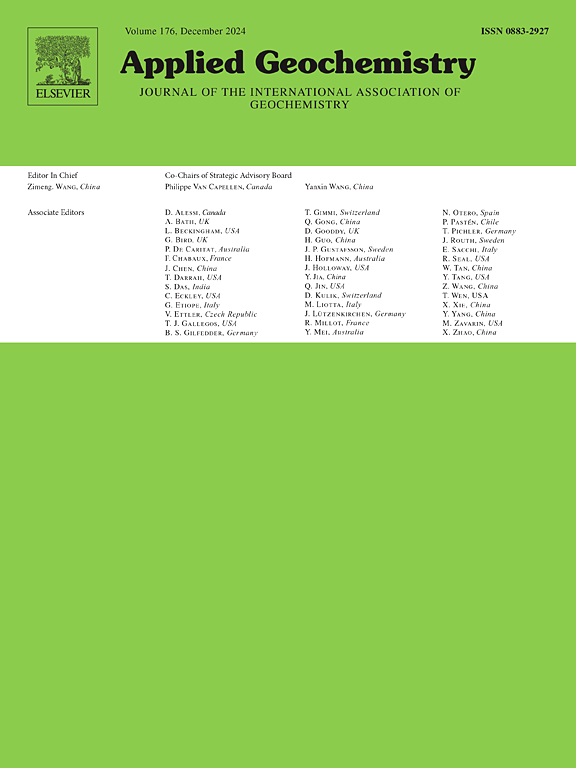Deep carbon degassing from strike-slip fault and rift system in India-Asia collision zone: Insights from fluid geochemistry in hydrothermal systems
IF 3.4
3区 地球科学
Q1 GEOCHEMISTRY & GEOPHYSICS
引用次数: 0
Abstract
Degassing of carbon-rich fluids through hydrothermal activities in continental fault systems represents one of the dominant ways within global carbon cycle. Complex phase transitions and geochemical transformations occur during their ascent to the surface, leading to chemical and isotopic composition alterations of fluids. Here, we present a combined dataset of chemical and isotopic data of spring water and bubbling gas samples collected from strike-slip Karakoram fault (KKF) and northern Xaniza rift (NXR) region in southern Tibetan Plateau, aiming to provide comprehensive constrain on the provenance and inventory of carbon-rich fluids in hydrothermal systems. The carbon isotopic compositions of dissolved inorganic carbon (DIC) positively correlate with dissolved values of CO2, suggesting significant hydrothermal degassing in the system. The initial concentrations and carbon isotopic compositions of pre-degassing DIC, as well as the degrees of degassing, are determined based on the fractionation modeling between gaseous CO2 and residual DIC. In order to provide a quantitative constraint on the pristine DIC inventory in hydrothermal waters, we conducted an integrated modeling method involving calcite precipitation, hydrothermal degassing, and mixing between deep-sourced carbon and organic matter. The modeling suggests that hydrothermal fluids from the NXR region exhibit slightly higher proportions of endogenic carbon (91.0%–95.9%) but lower contribution of subsurface organic matter (1.5%–6.8%) compared to the KKF region (75.1%–88.1% and 4.6%–24.9%). Our study emphasizes the substantial role of extensional continental rifting in deep carbon degassing through hydrothermal activities within the India-Asia collision zones.
印亚碰撞带走滑断裂和裂谷系统深层碳脱气:来自热液系统流体地球化学的启示
大陆断裂系统热液脱气是全球碳循环的主要途径之一。流体在上升到地表的过程中发生复杂的相变和地球化学变化,导致流体的化学和同位素组成发生变化。本文利用青藏高原南部喀喇昆仑走滑断裂(KKF)和北赞尼扎裂谷(NXR)地区的泉水和鼓泡气化学同位素数据,对热液系统富碳流体的来源和储量进行了综合约束。溶解无机碳(DIC)的碳同位素组成与CO2的溶解值正相关,表明该体系存在明显的热液脱气作用。基于气体CO2与残余DIC的分馏模型,确定了脱气前DIC的初始浓度、碳同位素组成以及脱气程度。为了对热液水域原始DIC储量提供定量约束,我们进行了方解石沉淀、热液脱气和深源碳与有机质混合的综合建模方法。模拟结果表明,相较于KKF地区(75.1% ~ 88.1%和4.6% ~ 24.9%),NXR地区热液中内源碳的比例(91.0% ~ 95.9%)略高,而地下有机质的贡献(1.5% ~ 6.8%)略低。本研究强调了伸展大陆裂陷作用在印亚碰撞带深部热液脱气中的重要作用。
本文章由计算机程序翻译,如有差异,请以英文原文为准。
求助全文
约1分钟内获得全文
求助全文
来源期刊

Applied Geochemistry
地学-地球化学与地球物理
CiteScore
6.10
自引率
8.80%
发文量
272
审稿时长
65 days
期刊介绍:
Applied Geochemistry is an international journal devoted to publication of original research papers, rapid research communications and selected review papers in geochemistry and urban geochemistry which have some practical application to an aspect of human endeavour, such as the preservation of the environment, health, waste disposal and the search for resources. Papers on applications of inorganic, organic and isotope geochemistry and geochemical processes are therefore welcome provided they meet the main criterion. Spatial and temporal monitoring case studies are only of interest to our international readership if they present new ideas of broad application.
Topics covered include: (1) Environmental geochemistry (including natural and anthropogenic aspects, and protection and remediation strategies); (2) Hydrogeochemistry (surface and groundwater); (3) Medical (urban) geochemistry; (4) The search for energy resources (in particular unconventional oil and gas or emerging metal resources); (5) Energy exploitation (in particular geothermal energy and CCS); (6) Upgrading of energy and mineral resources where there is a direct geochemical application; and (7) Waste disposal, including nuclear waste disposal.
 求助内容:
求助内容: 应助结果提醒方式:
应助结果提醒方式:


